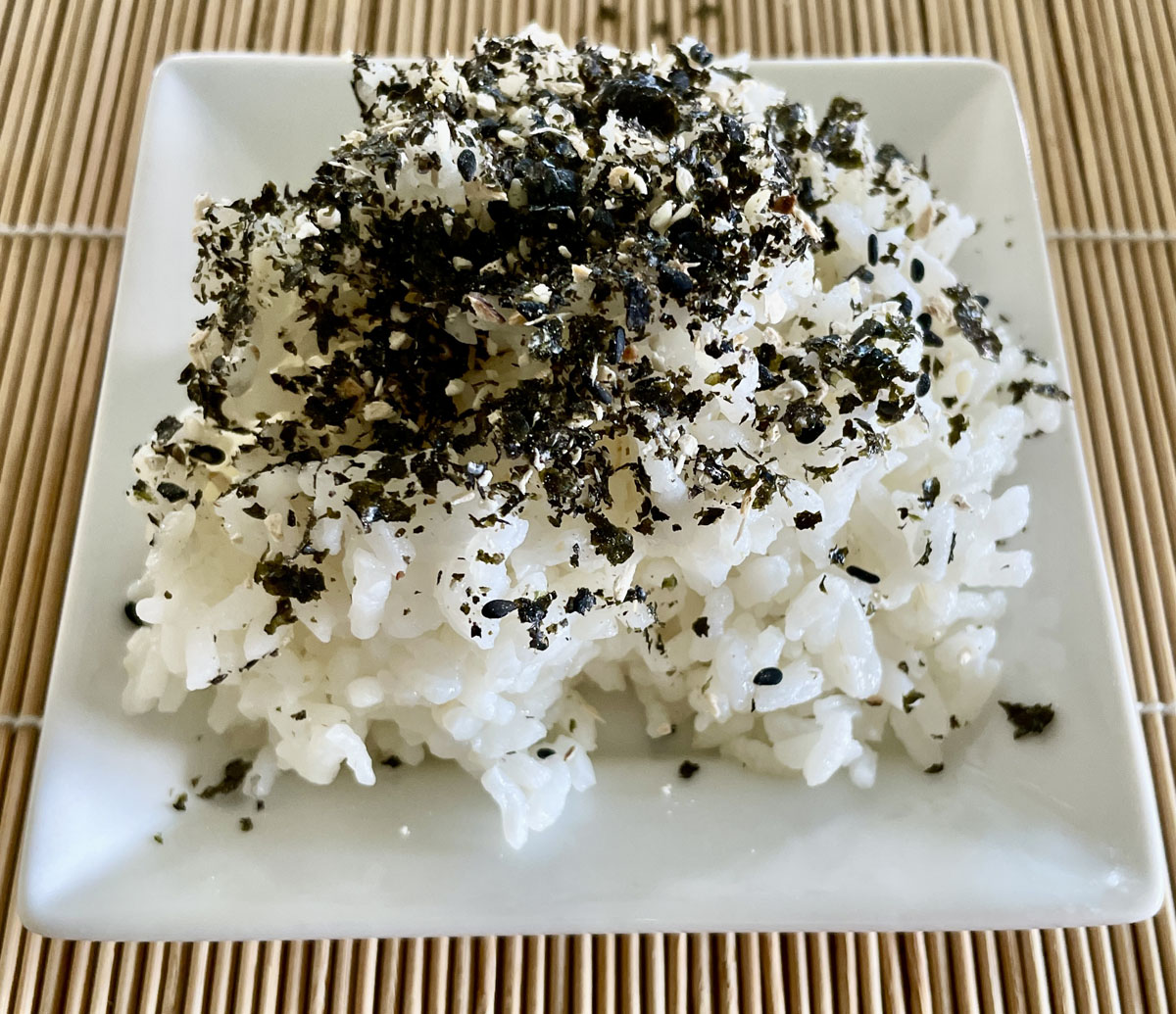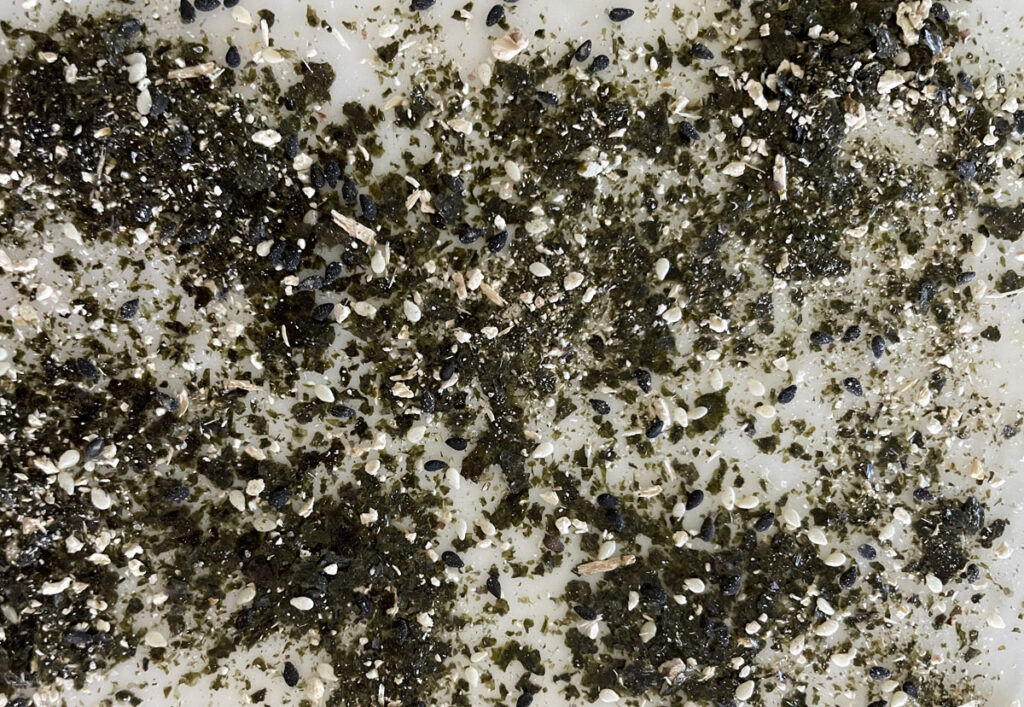
Local Food: This Is Tasty! A Recipe for Furikake

By Brittany P. Anderson
“Like furikake onda rice?” the question comes over the poke counter. The patron hesitates and looks around quizzically. “Say, ‘yes’,” the local man behind him encourages.
Furikake may be Hawai‘i Islandʻs favorite condiment. The basic formula is dried seaweed, dehydrated fish powder, and sesame seeds, but many variations exist. Furikake can be put on just about anything from rice to Chex Mix. Is there anything we won’t cover in furikake?
Seaweed has a long history of being eaten by many different cultures. Archeologists found evidence of cooked and partially eaten seaweed in the most ancient human settlement located in Chile. Hawaiians harvested and ate limu, a Hawaiian seaweed. Even modern Native Alaskans gather black seaweed from the outer coastal lands as their ancestors did for centuries. Dulse, common in North Atlantic countries like Iceland, Scotland, and Ireland, has been eaten for thousands of years.
The common thread between all these vastly different cultures is their proximity and dependence on the ocean. Harvesting abundant seaweed from the shorelines gave access to minerals and nutrients when fish were unavailable, or the sea was too volatile.
Seaweed is an excellent source of magnesium, calcium, iodine, and potassium. It also offers protein, dietary fiber, and vitamin C, all of which your body needs to stay healthy.
Unlike traditional food made with seaweed, furikake is a modern convention. From the late 1800s to the early 1900s, the population of Japan nearly doubled. The empire of Japan was expanding, and food shortages ensued. A bright pharmacist named Suekichi Yoshimaru saw calcium deficiencies becoming more and more widespread across the population. Suekichi decided to make a calcium supplement out of ground fish bones, but it needed to be palatable.
Suekichi mixed the fish bone meal with sesame seeds, poppy seeds, and nori (seaweed), calling his concoction “Gohan no Tomo,” or “A Friend for Rice.” It was a hit among the public! A Friend for Rice inspired other adaptations using slightly different ingredients. Seiichirō Kai was a grocery retailer who developed his own flavor called “Kore Wa Umai,” or “This is Tasty.” Instead of a fish bone meal, Seiichirō used a white fish flake. As his retail stores expanded into different parts of Japan, he created unique furikake blends for each area using regional ingredients. For instance, when his store opened in Tokyo, he made a furikake with dehydrated eggs.
In 1959, The National Furikake Association formed and gave birth to the furikake condiment class. The association formally recognized Suekichi Yoshimaru as the father of furikake and unified all the variations. In Japan, furikake is still used to boost health and vitality.
The name furikake is a blending of the Japanese verb ‘furi kakeruʻ, which means to sprinkle over. What a fitting name for the condiment Hawai‘i Islanders sprinkle over everything.
Today, furikake is available in various flavors and uses different seaweed types. Furikake can include anything, from bonito (fish) flakes, dehydrated egg, miso powder, and shitake powder.
Exiting the poke joint, the patron sits on a bench to enjoy his purchase. He looks at the rice topping, playing with it a little using his fork, trying to figure out why this green sprinkle tastes so good. The man, resigned to the fact that he is too embarrassed to ask what the topping is, shovels the rice and poke into his mouth. The local exits, sees the satisfaction on the man’s face, and throws him a shaka. Another furikake fan is born.
Furikake
1/2 cup white and/or black sesame seeds
2-3 seasoned nori sheets
1/2 tsp salt
2 tsp dried shiitake mushrooms
1-3 Tbs bonito flakes (optional)
1/2 tsp sugar (optional)
In a small food processor, pulse sesame seeds one or two times so that the seeds are partially ground, leaving some whole. Place the seeds in a cast iron skillet (or sauté pan) on low heat, stirring every minute or so until they become fragrant and lightly toasted, approximately 7–8 minutes. Stack, fold, and cut the nori sheets into small strips, then cut them into even smaller pieces. You can also pulse the nori in the food processor. Add the nori to the sesame seeds in a small bowl, salt, and any optional additions. Store in an air-tight container for up to six months. ❖




